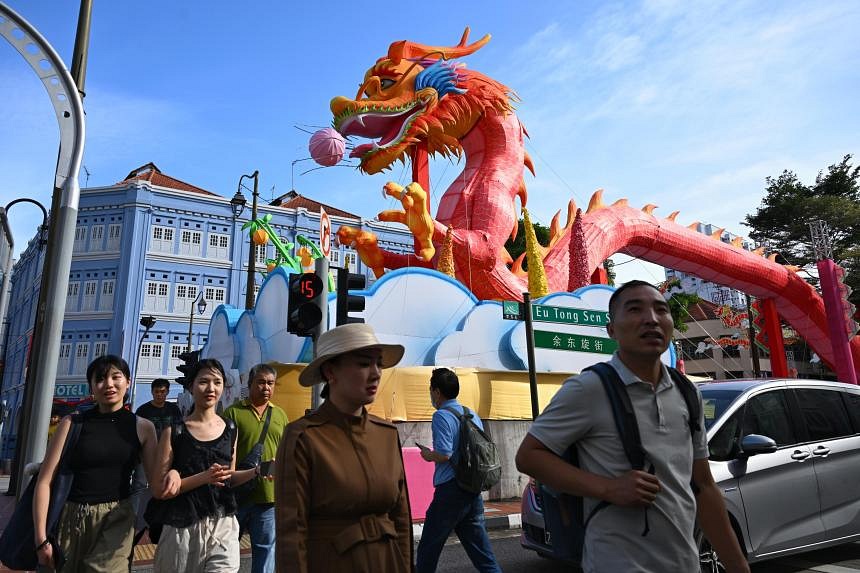SINGAPORE – Tourist arrivals from China have not bounced back to numbers chalked up before the Covid-19 pandemic, unlike other key markets such as Australia and India, but the Singapore Tourism Board (STB) is bullish that this is just a matter of time.
One reason for the confidence is that weekly flights between Singapore and China have recovered to 100 per cent of pre-pandemic levels since end-January 2024, said STB chief executive Melissa Ow.
“For us, that is a great signal as to how airlines are also reading and interpreting market demand signals – it is overall a positive picture,” Ms Ow said in an exclusive interview with The Straits Times on Feb 1.
With the mutual 30-day, visa-free arrangement between China and Singapore kicking off on Feb 9, the authorities expect an imminent boost in visitors from China, an important market whose absence has been keenly felt.
Pre-pandemic, China was Singapore’s top source of tourists, hitting a peak of 3.6 million arrivals in 2019. But since then, the Chinese have increasingly spent their tourist dollars at home as they awaited a global air travel recovery.
In 2023, China accounted for 1.4 million visitors here – still enough for second place, ahead of Malaysia (1.1 million), but far short of top market Indonesia (2.3 million).
This is only a glimpse of the recovery to come, with STB expecting more of an uptick in 2024, said Ms Ow.
“China will continue to be a very significant contributor to global tourism, and Singapore should certainly continue to work hard to vie for a share of that growing market,” she said.
STB’s strategy over the past decade has been to invest not only in Tier 1 cities like Beijing and Shanghai, but also Tier 2 cities such as Qingdao and Wuhan, and cities with direct flights to Singapore.
This is because such cities have “a sizeable target audience that we think will be a good fit for the Singapore tourism product and destination”, said Ms Ow, who took over as STB chief in June 2023.
STB is using a similar strategy for the Tier 2 cities of another key market, India, such as Hyderabad and Ahmedabad. India was the Republic’s fifth largest market in 2023, with 1.1 million visitors.
On the better-than-expected tourism dollars that Singapore recorded in 2023, which outpaced the growth in arrivals, Ms Ow said visitors are staying for longer, possibly to justify their higher airfares.
Tourism receipts are estimated to be between $24.5 billion and $26 billion for 2023, surpassing the initial forecast of $18 billion to $21 billion. On average, tourists stayed for 3.8 days, against 3.4 days in 2019.
As visitors stay for longer, their average spend goes up accordingly – a pattern that STB hopes will continue, said Ms Ow.
One bright spot among the categories of tourist spending is food and beverage, which went up from $1.9 billion for the period from January to September 2019, to $3 billion for the same period in 2023.
Ms Ow pegged this to Singapore’s thriving F&B scene, which has attracted a slew of culinary talent and seen new restaurant openings. There has also been a greater push to publicise home-grown F&B talent.

“Our mixologists and bar scene, and partnerships with entities like World’s 50 Best Bars, have helped to cast a spotlight on Singapore as a great nightlife destination, but at the same time, there are extraordinary experiences for foodies,” she said. “It is helping us to really grow mindshare of Singapore as a culinary capital of the world.”
Industry analysts said Singapore’s 2023 tourism performance makes an argument for greater focus on tourist spending over arrival numbers, though both have been longstanding measures of tourism sector health.
“What is more important is to ensure we are attracting the relevant profiles of both leisure and business visitors – those who are able and prepared to spend more money while in Singapore and stay longer,” said Mr Benjamin Cassim, a senior lecturer for the diploma in hospitality and tourism management course at Temasek Polytechnic.
“It is important to recognise what Singapore has to offer as a tourist destination in terms of the higher-value visitor experiences that come with higher price points.”
Ms Ow said part of STB’s strategy going into 2024 is to continue to drive higher-quality experiences, and for visitors to derive value from longer stays.
“If you look at the way we position and market Singapore, and the type of attractions, events and experiences we are introducing, they are of a certain standing and quality, which (in turn) will help us to become more attractive to segments of higher-spending visitors,” Ms Ow said.
Doing so will help the sector continue to draw in good tourist spending even if visitor arrival numbers do not reach pre-pandemic levels until 2025 due to possible economic headwinds, she said.
The value proposition is that “a visit to Singapore isn’t just based on the fact that there is an entire spread, concentration and compactness of experiences, but also the efficiency, convenience and connectivity we have as a city”, Ms Ow said.


